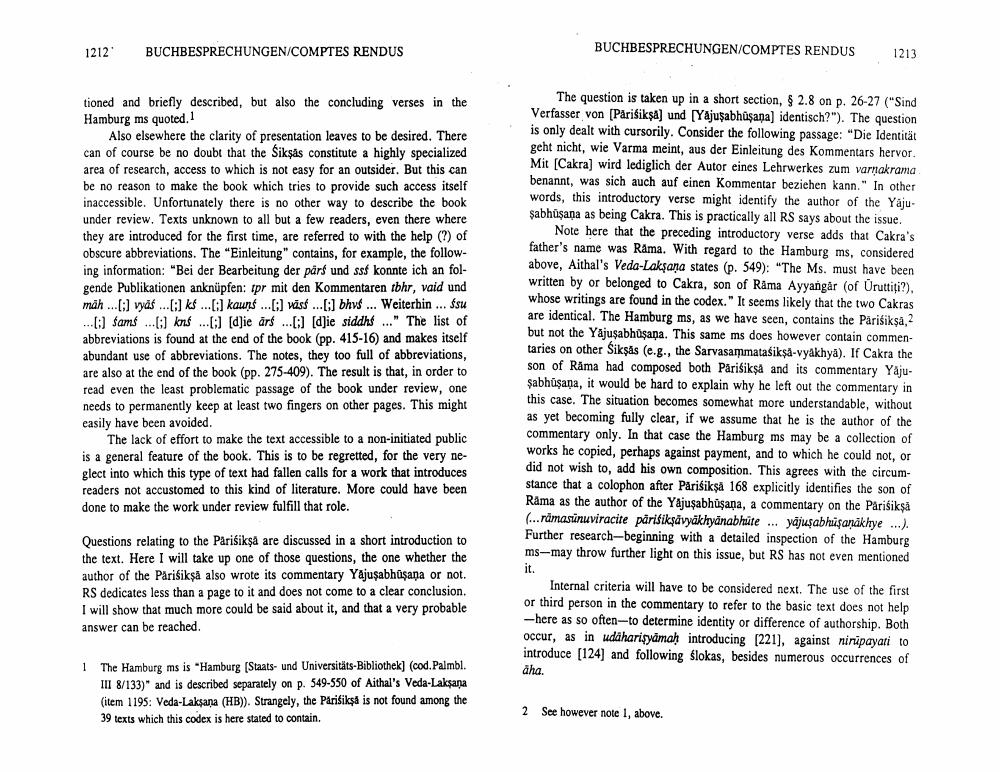Book Title: Buchbesprechungen Comptes Rendus Author(s): Johannes Bronkhorst Publisher: Johannes Bronkhorst View full book textPage 2
________________ 1212 BUCHBESPRECHUNGEN/COMPTES RENDUS tioned and briefly described, but also the concluding verses in the Hamburg ms quoted. 1 Also elsewhere the clarity of presentation leaves to be desired. There can of course be no doubt that the Siksäs constitute a highly specialized area of research, access to which is not easy for an outsider. But this can be no reason to make the book which tries to provide such access itself inaccessible. Unfortunately there is no other way to describe the book under review. Texts unknown to all but a few readers, even there where they are introduced for the first time, are referred to with the help (?) of obscure abbreviations. The "Einleitung" contains, for example, the following information: "Bei der Bearbeitung der pårs und ssf konnte ich an folgende Publikationen anknüpfen: tpr mit den Kommentaren tbhr, vaid und mah...[:] vyas...[:] ks...[:] kauns ...[:] vass...[:] bhvs... Weiterhin ... su ...[:] sams...] kns[:] [d]ie ārs[:] [d]ie siddhs..." The list of abbreviations is found at the end of the book (pp. 415-16) and makes itself abundant use of abbreviations. The notes, they too full of abbreviations, are also at the end of the book (pp. 275-409). The result is that, in order to read even the least problematic passage of the book under review, one needs to permanently keep at least two fingers on other pages. This might easily have been avoided. The lack of effort to make the text accessible to a non-initiated public is a general feature of the book. This is to be regretted, for the very neglect into which this type of text had fallen calls for a work that introduces readers not accustomed to this kind of literature. More could have been done to make the work under review fulfill that role. Questions relating to the Parisikșă are discussed in a short introduction to the text. Here I will take up one of those questions, the one whether the author of the Pärisikșă also wrote its commentary Yajuşabhūṣaṇa or not. RS dedicates less than a page to it and does not come to a clear conclusion. I will show that much more could be said about it, and that a very probable answer can be reached. 1 The Hamburg ms is "Hamburg (Staats- und Universitäts-Bibliothek) (cod. Palmbl. III 8/133)" and is described separately on p. 549-550 of Aithal's Veda-Lakṣaṇa (item 1195: Veda-Laksana (HB)). Strangely, the Păriśiksă is not found among the 39 texts which this codex is here stated to contain. BUCHBESPRECHUNGEN/COMPTES RENDUS 2 1213 The question is taken up in a short section, § 2.8 on p. 26-27 ("Sind Verfasser von [Parisikṣa] und [Yajuṣabhüşaṇa] identisch?"). The question is only dealt with cursorily. Consider the following passage: "Die Identität geht nicht, wie Varma meint, aus der Einleitung des Kommentars hervor. Mit [Cakra] wird lediglich der Autor eines Lehrwerkes zum varṇakrama. benannt, was sich auch auf einen Kommentar beziehen kann." In other words, this introductory verse might identify the author of the Yajuşabhüşana as being Cakra. This is practically all RS says about the issue. Note here that the preceding introductory verse adds that Cakra's father's name was Rama. With regard to the Hamburg ms, considered above, Aithal's Veda-Laksana states (p. 549): "The Ms. must have been written by or belonged to Cakra, son of Rama Ayyangår (of Uruttiti?), whose writings are found in the codex." It seems likely that the two Cakras are identical. The Hamburg ms, as we have seen, contains the Pariśikşa,2 but not the Yajuşabhüşaṇa. This same ms does however contain commentaries on other Siksas (e.g., the Sarvasammatašikṣa-vyakhya). If Cakra the son of Rama had composed both Parisikşa and its commentary Yajuşabhüşaṇa, it would be hard to explain why he left out the commentary in this case. The situation becomes somewhat more understandable, without as yet becoming fully clear, if we assume that he is the author of the commentary only. In that case the Hamburg ms may be a collection of works he copied, perhaps against payment, and to which he could not, or did not wish to, add his own composition. This agrees with the circumstance that a colophon after Parisikșă 168 explicitly identifies the son of Rama as the author of the Yajuşabhüşaṇa, a commentary on the Parisikșă (...rämasünuviracite pärisikşävyäkhyänabhüte yajuşabhüşaṇākhye ...). Further research-beginning with a detailed inspection of the Hamburg ms-may throw further light on this issue, but RS has not even mentioned it. Internal criteria will have to be considered next. The use of the first or third person in the commentary to refer to the basic text does not help -here as so often-to determine identity or difference of authorship. Both occur, as in udaharişyāmaḥ introducing [221], against nirupayati to introduce [124] and following slokas, besides numerous occurrences of äha. See however note 1, above.Page Navigation
1 2 3 4 5 6 7 8
